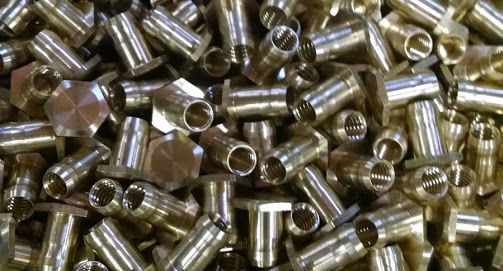Deburring describes the breaking of unwanted sharp edges, or burrs, which develop during the plating process. Deburring is also sometimes necessary to tidy and smooth components before they enter the plating baths.
Hand filing was once the only means of deburring plated materials, and it is still used in some circumstances today. Hand filing, however, requires a significant time investment, which greatly affects the timely delivery of finished products. Mechanical deburring techniques provide high-quality finishes at a fraction of the time.
Deburring, Radiusing or Polishing?
Deburring isn’t the only finishing used to smooth plated materials. Deburring abrasives act like hundreds of tiny files, breaking down sharp burrs. Radiusing, a related finishing technique, grinds sharp edges down to create smooth, round contours. Surface smoothing is used when the burrs form sharp peaks.
Polishing removes metal with an abrasive belt or grinding material, and it is the technique of choice when removing large pieces of metal. Buffing, which gives a surface its final finish, may also be used to remove small burrs. For functional parts which don’t require a decorative finish, deburring often provides the final finish.
Polishing and Deburring Methods
Deburring methods include polishing, brushing and tumbling, flexible polishing, and satin finishing, which produces a smooth directional finish.
Polishing or processing wheels use different coverings depending on the delicacy of the item being deburred. Muslin, canvas, felt and even leather are all used, but cotton fabric wheels are the most common. Cotton fabric wheels provide consistent results, are used to remove a range of burr sizes, and are also the most economically viable.
The surface requiring deburring determines the rigidity of the polishing wheel. Rigid canvas wheels are used for flat surfaces with little contouring and for rapid deburring of large amounts of metal. More delicate parts with restricted areas require a less rigid processing wheel and softer materials such as muslin.
Items with irregular contours and small burrs need a sewn or loose cotton buff to avoid damaging the finished item. For intricate parts requiring a wheel with great flexibility, special processing wheels called string wheels and Tampico wheels are used.
Polishing Compounds
Processing wheels work with a greaseless compound composed of water, glue and an abrasive. The abrasive provides the friction required to grind down burrs and comes in different grades. Silicon carbide grades are commonly used for stainless steel and aluminum finishes, while aluminum oxide is used for brass and nonferrous metals. Aluminum oxide is also used to remove burrs on carbon steel prior to immersion in plating baths.
Tumbling and Brushing
Tumbling removes burrs from durable components by agitating them with abrasives in a large barrel – the effect is not unlike those stone-polishing toys sold at science toy stores. Tumble and vibratory bowl finishing use multiple types of media (shapes and material) to radius, polish, and de-burr metal parts directly after manufacture and prior to any subsequent plating step. While plating can create burrs, this is usually because the metal substrate already has burrs from which the plating exacerbates.
Brushing uses high-speed brushes to wear down burrs, often using nylon abrasive filament bristles.
At Sharretts Plating Company, we offer the most up-to-date deburring techniques, so your finished product is free of burrs which interfere with both appearance and function.





